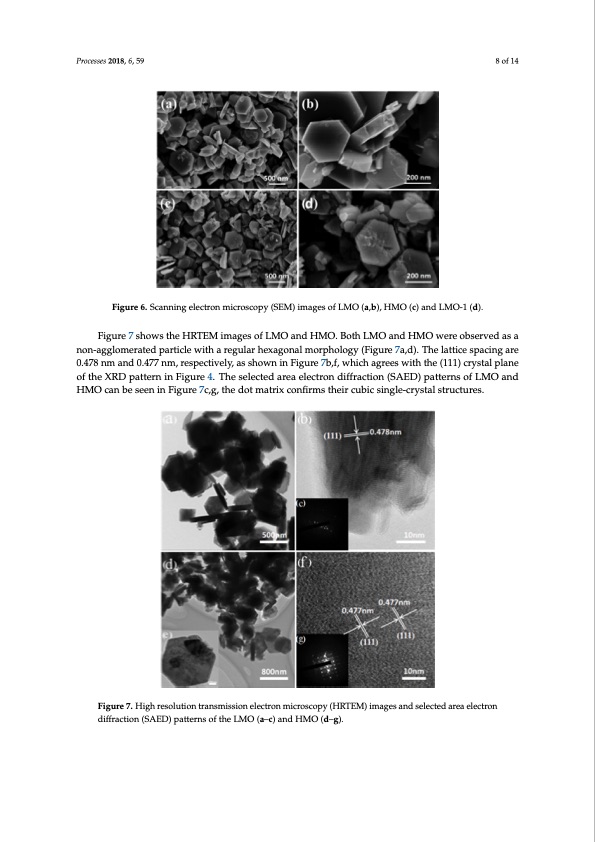
PDF Publication Title:
Text from PDF Page: 008
Processes 2018, 6, 59 Processes 2018, 6, x FOR PEER REVIEW Processes 2018, 6, x FOR PEER REVIEW 8 of 14 8 of 14 8 of 14 Figure 6. Scanning electron microscopy (SEM) images of LMO (a,b), HMO (c) and LMO-1 (d). Figure 6. Scanning electron microscopy (SEM) images of LMO (a,b), HMO (c) and LMO-1 (d). FiguFriegu6.reSc7anshnoinwgsetlheectHroRnTmEMicroimscaogpeys (oSfELM)OimaangdesHoMf OLM. BOot(ha,LbM), HOManOd(Hc)ManOdwLeMreOo-1bs(edr)v. ed as a non-agglomerated particle with a regular hexagonal morphology (Figure 7a,d). The lattice spacing Figure 7 shows the HRTEM images of LMO and HMO. Both LMO and HMO were observed as a Figure 7 shows the HRTEM images of LMO and HMO. Both LMO and HMO were observed as are 0.478 nm and 0.477 nm, respectively, as shown in Figure 7b,f, which agrees with the (111) crystal non-agglomerated particle with a regular hexagonal morphology (Figure 7a,d). The lattice spacing are a non-agglomerated particle with a regular hexagonal morphology (Figure 7a,d). The lattice spacing plane of the XRD pattern in Figure 4. The selected area electron diffraction (SAED) patterns of LMO 0.478 nm and 0.477 nm, respectively, as shown in Figure 7b,f, which agrees with the (111) crystal plane are 0.478 nm and 0.477 nm, respectively, as shown in Figure 7b,f, which agrees with the (111) crystal and HMO can be seen in Figure 7c,g, the dot matrix confirms their cubic single-crystal structures. of the XRD pattern in Figure 4. The selected area electron diffraction (SAED) patterns of LMO and plane of the XRD pattern in Figure 4. The selected area electron diffraction (SAED) patterns of LMO HMO can be seen in Figure 7c,g, the dot matrix confirms their cubic single-crystal structures. and HMO can be seen in Figure 7c,g, the dot matrix confirms their cubic single-crystal structures. Figure 7. high resolution transmission electron microscopy (HRTEM) images and selected area electron diffraction (SAED) patterns of the LMO (a–c) and HMO (d–g). Figure 7. high resolution transmission electron microscopy (HRTEM) images and selected Figure 7. High resolution transmission electron microscopy (HRTEM) images and selected area electron area electron diffraction (SAED) patterns of the LMO (a–c) and HMO (d–g). diffraction (SAED) patterns of the LMO (a–c) and HMO (d–g).PDF Image | Sieves for Highly Selective Li Adsorption

PDF Search Title:
Sieves for Highly Selective Li AdsorptionOriginal File Name Searched:
processes-06-00059-v2.pdfDIY PDF Search: Google It | Yahoo | Bing
Product and Development Focus for Infinity Turbine
ORC Waste Heat Turbine and ORC System Build Plans: All turbine plans are $10,000 each. This allows you to build a system and then consider licensing for production after you have completed and tested a unit.Redox Flow Battery Technology: With the advent of the new USA tax credits for producing and selling batteries ($35/kW) we are focussing on a simple flow battery using shipping containers as the modular electrolyte storage units with tax credits up to $140,000 per system. Our main focus is on the salt battery. This battery can be used for both thermal and electrical storage applications. We call it the Cogeneration Battery or Cogen Battery. One project is converting salt (brine) based water conditioners to simultaneously produce power. In addition, there are many opportunities to extract Lithium from brine (salt lakes, groundwater, and producer water).Salt water or brine are huge sources for lithium. Most of the worlds lithium is acquired from a brine source. It's even in seawater in a low concentration. Brine is also a byproduct of huge powerplants, which can now use that as an electrolyte and a huge flow battery (which allows storage at the source).We welcome any business and equipment inquiries, as well as licensing our turbines for manufacturing.| CONTACT TEL: 608-238-6001 Email: greg@infinityturbine.com | RSS | AMP |